 One of our most mystical native birds, the rare nightjar, appears to be thriving in the New Forest following historic declines in the rest of the UK.
One of our most mystical native birds, the rare nightjar, appears to be thriving in the New Forest following historic declines in the rest of the UK.
Early results of a survey jointly funded by the New Forest National Park Authority, the Forestry Commission and the New Forest Verderers as part of the New Forest Higher Level Stewardship (HLS) scheme, show the nightjar population appears to be returning to the New Forest in good numbers each spring from its winter habitat in Africa.
The survey shows the management of the Forest is providing good habitat for them.
Over the summer, experts from international environmental consulting company RPS tracked the ground-nesting, nocturnal birds, which can best be seen and heard in heathland at dusk or just before sunrise. Nearly 550 male birds were recorded.
The last nightjar survey in the Forest was carried out in 2004/2005 as part of wider national surveys and these latest results will provide a better understanding of the birds’ nesting behaviour and the factors affecting their distribution and habitats. The data could help identify ways to further improve the Forest for nightjar.
New Forest National Park Authority Ecologist Ian Barker said: ‘The species has been considered rare and threatened in the UK and Europe after significant decline in numbers and reduced areas of habitat. It is ‘red listed’ by wildlife experts in the UK, meaning it is of the highest conservation priority, with species needing urgent action.
‘Careful habitat management has led to a rise in population in recent years but more work still needs to be done to maintain this progress. The New Forest is considered to be a particular stronghold and it’s important this is maintained to assist the species’ recovery locally and nationally.’
The New Forest HLS scheme – worth £16m of European money over 10 years – is Europe’s largest agri-environment scheme.
The New Forest HLS supports:
- Commoning – crucial grants and expert advice have been provided to hundreds of commoners to continue their ancient way of life turning out ponies and cattle onto the New Forest
- Wetland restoration – nine miles of artificially straightened drainage channels have been restored to natural streams, protecting the New Forest’s internationally-important wetlands by slowing water flow.
- Archaeology – 12,000 hectares, equivalent to 17,000 football pitches, has been surveyed; finding and recording thousands of historical sites to stop them being lost forever
- Education – More than 11,000 children have gained a greater understanding of the New Forest through school visits
- Habitat management – invasive rhododendron and other non-native species have been removed or reduced across approximately half of the New Forest, helping native plants flourish.
The scheme was announced in March 2010 following a successful bid from a partnership between the Verderers, Commoners, New Forest National Park Authority, the Forestry Commission and Natural England.
Further rare bird surveys of waders and Dartford warbler and woodlark will continue to take place in the New Forest..
For more information about rare birds in the New Forest visit www.newforestnpa.gov.uk/wildlife.
-ends-
Nightjar Facts
- Nightjars are mystical birds, appearing in the early summer after a long migration from Africa. The first sign of their return is their churring song heard after dusk.
- Being nocturnal and highly camouflaged they are rarely seen during the daytime. At night their ghost-like flight led to them being associated with folklore. In some parts of the country it was known as the goatsucker or fern owl.
- Nightjars make their nests on the ground and so can be vulnerable to human disturbance. Visitors to the New Forest can help by taking note of any signs warning of ground nesting birds and having regard to the New Forest dog walking code.